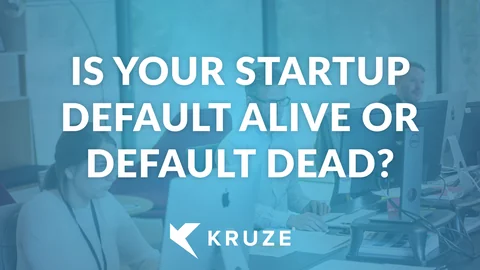
Paul Graham, the entrepreneur that founded the startup incubator Y Combinator, asks a very famous question when he meets a founder: “Is your startup default alive or default dead?” Let’s look at what that means.
Specifically, Graham wants to know if the business is going to reach profitability before running out of money:
- Default alive: If your business is “default alive” it means that your startup is on the path to no longer needing new capital from outside investment. You are going to be able to get by without further investment and, therefore, you control your own destiny.
- Default dead: If your startup is “default dead” it means you are going to have to have an outsider write another check for your company in order to keep your business running.
In this context, the word “path” is really important. There are a lot of startups, if not most startups, that are trying to grow as fast as possible. This often means they are also burning cash.
The word “path” implies you are in the position to reduce your startup's burn rate. For example, if times get tough or something happens which impacts your default alive status, you need to be able to cut your burn rate to maintain said status. The question you have to ask yourself here is “can you cut your burn and still have a healthy company?”. If you can, you are on the path to being default alive.
Cutting your burn rate
Cutting your startup’s burn rate is particularly relevant right now, in early 2023, and over the last six months there has been a lot of startups finding this out. They are looking in the mirror and either trimming around the edges or making deeper cuts so that their business can remain default alive.
Being default alive, especially in tougher times, is a really good status to hold. One of the best aspects of being default alive is the powerful message it sends to your investors. Knowing that they don’t need to put any more capital into the business has multiple benefits for them:
- Investors can earmark some of that capital for other promising companies that are struggling and do need more money.
- Being default alive gives your investors a lot of confidence in the startup’s management team. It shows them that the business is going somewhere.
A healthy growing startup
With this in mind, you don’t want to cut down to the bone and stop your startup from being able to function as a company. You want to aim for a strategic reduction that means you still have a healthy growing company, you’re just not growing as fast as you could have been if you were burning a lot more cash.
Default alive is an excellent place to be, especially when you’ve got your hands on the wheel and you know how to hit the brakes, slow things down and maintain that cash cushion so that you can continue to function in the future.
And if you do need to cut a little bit, now is a good time to do so. There are a lot of layoffs happening at small startups as well as big companies, including Google, Microsoft, and Amazon.
Talk to your startup accountant
If you are looking at cutting your burn rate, talk to your accountant! Being default alive is a powerful concept and your CPA can help you in this area. For example, here at Kruze Consulting, we give our startups a burn rate calculation every month. This means they know exactly how much cash runway they have and from that they can figure out if they are default alive or default dead. If you have any questions on burn rate, startup accounting, taxes, or venture capital please contact us. You can also follow our youtube channel and our blog for more information about accounting, finance, HR, and taxes for startups!








